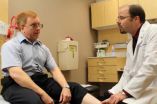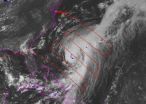(Press-News.org) DETROIT – A new stereotactic radiosurgery system provides the same or a higher level of accuracy in targeting cancer tumors – but offers greater comfort to patients and the ability to treat multiple tumors at once – when compared to other radiation therapy stereotactic systems, according to researchers at Henry Ford Hospital in Detroit.
The study shows the Edge™ Radiosurgery Suite is able to target cancer tumors within 1 mm, providing sub-millimeter accuracy with extreme precision.
"Radiosurgery is just one shot of precision radiation with a very high dose to treat tumors," says study lead author Ning Wen, Ph.D., a physicist with the Department of Radiation Oncology at Henry Ford.
"The key is targeting the tumor and delivering the dose that we want while protecting surrounding normal tissue, which is why it is so important to regularly evaluate the systematic accuracy of such systems."
The study will presented Sept. 16 at the 56th annual American Society for Radiation Oncology (ASTRO) meeting in San Francisco.
Stereotactic radiation is a procedure that precisely delivers intense radiation doses to tumor targets in one to five treatments. The goal of this non-invasive procedure is to destroy, or make inactive, the tumor while minimizing dose exposure to the surrounding healthy tissue.
The Edge, created by Varian Medical Systems, is the latest advancement in stereotactic radiosurgery. It offers treatment in about 20 minutes and uses new real-time tumor tracking technology to help compensate for tumor motion during treatment. Its six degrees of freedom treatment couch provides flexibility needed to optimally position and adjust patients, allowing them to be comfortable and breathe freely during treatment.
Henry Ford was the first in North America and it is the only hospital in Michigan to have the Edge.
"The Edge truly represents a novel platform in radiosurgery, offering a system that provides a fully-integrated solution for planning and administering radiosurgery treatments," notes Benjamin Movsas, M.D., Chair of the Department of Radiation Oncology at Henry Ford and a co-author of the study.
For its study, Henry Ford sought to evaluate the accuracy of the Edge by comparing it to existing robot- or frame-based radiosurgery systems.
To do so, researchers took a novel approach using – for the first time – a phantom prototype cube to determine treatment precision.
The phantom includes implanted inserts and has four different densities for cone beam computed tomography, three Calypso beacons, 5 mm diameter steel BBs in the center for localization accuracy testing, 16 ceramic BBs for radiographic imaging, and simultaneous dual orthogonal film planes insert for dosimetric verification.
With the phantom prototype, targets were localized using all components of the Edge system, including optical surface monitoring system, electromagnetic beacon-based tracking, cone-beam CT, "snap-shot" planar x-ray imaging during treatment and a "robotic" six degree of freedom couch.
Ten plans were created to study various treatment sites including brain, spine, lung and pancreas.
Overall, the study demonstrated that the "end-to-end" locational accuracy of the Edge was within 0.9 mm for single target treatment and 1.2 mm for single isocenter multi-targets treatment, making it highly accurate when compared to robot- or frame-based radiosurgery systems.
"With our radiosurgery team, everything we do is continuously under study," says Dr. Wen. "As pioneers in the field, we want to show we have done due diligence with this new system to ensure we're providing the best care to our patients."
Dr. Wen and his colleagues plan to continue to study the Edge, expanding their research to evaluation how tumors interact with treatment.
INFORMATION:
Along with Drs. Wen and Movsas, Henry Ford study co-authors are Haisen Li, Ph.D.; Kang Song, Karen Chin Snyder, Jinkoo Kim, Hualiang Zhong, James Gordon, Ph.D.; Indrin Chetty, Ph.D.; Salim Siddiqui, M.D.; Farzan Siddiqui, M.D.; Munther Ajlouni, M.D.; and Samuel Ryu, M.D.
Research support for this study was provided by Varian and Henry Ford Hospital.
New radiosurgery technology provides highly accurate treatment, greater patient comfort
2014-09-16
ELSE PRESS RELEASES FROM THIS DATE:
Patient's question triggers important study about blood thinners
2014-09-16
Ottawa – September 16, 2014 – Physicians around the world now have guidance that can help them determine the best oral blood thinners to use for their patients suffering from blood clots in their veins, thanks to a patient of The Ottawa Hospital who asked his physician a question he couldn't answer. This new guidance is found in a study published today by JAMA, the Journal of the American Medical Association.
"Right there in the clinic, he identified an important knowledge gap for clinicians. We decided to act on it and find the answer," says hematologist Dr. Marc Carrier, ...
Novel capability enables first test of real turbine engine conditions
2014-09-16
Manufactures of turbine engines for airplanes, automobiles and electric generation plants could expedite the development of more durable, energy-efficient turbine blades thanks to a partnership between the U.S. Department of Energy's Argonne National Laboratory, the German Aerospace Center and the universities of Central Florida and Cleveland State.
The ability to operate turbine blades at higher temperatures improves efficiency and reduces energy costs. For example, energy companies estimate that raising the operating temperature by 1 percent at a single electric generation ...
Boosting global corn yields depends on improving nutrient balance
2014-09-16
WEST LAFAYETTE, Ind. - Ensuring that corn absorbs the right balance of nitrogen, phosphorus and potassium is crucial to increasing global yields, a Purdue and Kansas State University study finds.
A review of data from more than 150 studies from the U.S. and other regions showed that high yields were linked to production systems in which corn plants took up key nutrients at specific ratios - nitrogen and phosphorus at a ratio of 5-to-1 and nitrogen and potassium at a ratio of 1-to-1. These nutrient uptake ratios were associated with high yields regardless of the region ...
Dry conditions and lightning strikes make for a long California fire season
2014-09-16
The fire season in California has been anything but cooperative this year. Hot conditions combined with a state-wide drought and dry lightning makes for unpleasant conditions and leads to an abundance of forest fires.
On August 12, lightning struck and started the fire that grew into the Happy Camp Complex. Currently over 113,000 acres have been affected and the fire is only 55% contained as of today. Strong winds tested fire lines yesterday (8/15), and are expected to do so again today. Despite the high winds, existing fire lines held with no spotting or expansion ...
Do wearable lifestyle activity monitors really work?
2014-09-16
Wearable electronic activity monitors hold great promise in helping people to reach their fitness and health goals. These increasingly sophisticated devices help the wearers improve their wellness by constantly monitoring their activities and bodily responses. This information is organized into companion computer programs and mobile apps.
Given the large and quickly growing market for these devices, researchers at the University of Texas Medical Branch at Galveston analyzed 13 of these activity monitors, such as those made by Fitbit, Jawbone or Nike, to compare how the ...
NASA HS3 instrument views 2 dimensions of clouds
2014-09-16
VIDEO:
Global Hawk observes the Saharan Air Layer through the Cloud Physics Lidar(CPL) during Hurricane Nadine (id 4102). More information on this topic available at:
http://www.nasa.gov/content/goddard/nasa-hs3-instrument-views-2-dimensions-of-clouds/....
Click here for more information.
NASA's Cloud Physics Lidar (CPL) instrument, flying aboard an unmanned Global Hawk aircraft in this summer's Hurricane and Severe Storm Sentinel, or HS3, mission, is studying the changing profile ...
NASA's HS3 mission covers transition of Hurricane Cristobal
2014-09-16
NASA's Global Hawk 872 aircraft flew over Hurricane Cristobal on August 28 and 29 and gathered data on the storm as it was becoming extra-tropical.
NASA's airborne Hurricane and Severe Storm Sentinel, or HS3, mission kicked off on August 26 when one of the remotely piloted Global Hawk aircraft flew a "lawnmower" or back and forth pattern over Hurricane Cristobal while gathering data using dropsondes and two other instruments. The Global Hawk dropped 81 dropsondes over Cristobal. A dropsonde is a device that measures winds, temperature, pressure and humidity as it falls ...
Results of OCT STEMI trial reported at TCT 2014
2014-09-16
WASHINGTON, DC – September 16, 2014 – The first randomized trial to examine serial optical coherence tomography (OCT) in primary percutaneous coronary intervention (PCI) was reported at the 26th annual Transcatheter Cardiovascular Therapeutics (TCT) scientific symposium. Sponsored by the Cardiovascular Research Foundation (CRF), TCT is the world's premier educational meeting specializing in interventional cardiovascular medicine.
OCT uses light emitted from an intravascular catheter to capture high-resolution cross sectional imaging from within coronary arteries. OCT ...
Results of IVUS-CTO trial reported at TCT 2014
2014-09-16
WASHINGTON, DC – September 14, 2014 – A new study found that intravascular ultrasound (IVUS) -guided intervention in patients with chronic total occlusion (CTO) could improve outcomes compared to a conventional angiography-guided approach during percutaneous coronary intervention (PCI). The IVUS-CTO study is the first randomized trial to examine the clinical impact of IVUS guidance for CTO intervention.
Findings were reported today at the 26th annual Transcatheter Cardiovascular Therapeutics (TCT) scientific symposium. Sponsored by the Cardiovascular Research Foundation ...
Epigenetic drugs: A hope to treat cancer resistance and reduce cancer relapse?
2014-09-16
High school biology taught us that we inherit certain traits from our parents that are pre-determined. But what if you could change how these genes play out by taking certain drugs or better yet, just changing your diet? That's exactly what a team of researchers at the Boston University School of Medicine (BUSM) have proposed through their research of epigenetics research.
Epigenetics regulates gene expression in a reversible manner by chemically modifying DNA and histone proteins, which prevent permanent mutations or alterations within the gene themselves. Throughout ...




